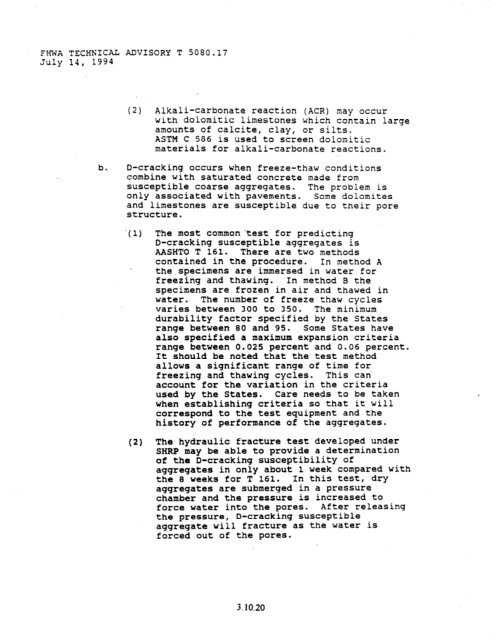chapter 3 rigid pavement - DOT On-Line Publications - Department ...
chapter 3 rigid pavement - DOT On-Line Publications - Department ...
chapter 3 rigid pavement - DOT On-Line Publications - Department ...
You also want an ePaper? Increase the reach of your titles
YUMPU automatically turns print PDFs into web optimized ePapers that Google loves.
L "HWA TECHKICti ADVISORY T 5080.17<br />
July 14, 1994<br />
(2) Alkali-carbonate reaction (ACR) may occur<br />
with dolomitic limestones which contain large<br />
amounts of calcite, clay, or silts.<br />
ASTM C 586 is used to screen dolomitic<br />
materials for alkali-carbonate reactions.<br />
b. D-cracking occurs when freeze-thaw conditions<br />
combine with saturated concrete made from<br />
susceptible coarse aggregates. The problem is<br />
only associated with <strong>pavement</strong>s. Some dolomites<br />
and limestones are susceptible due to their pore<br />
structure.<br />
'(1) The most common test for predicting<br />
D-cracking susceptible aggregates is<br />
AASHTO T 161. There are two methods<br />
contained in the procedure. In method A<br />
the.specimens are immersed in water for<br />
freezing and thawing. In method B the<br />
specimens are frozen in air and thawed in<br />
water. The number of freeze thaw cycles<br />
varies between 300 to 350. The minimum<br />
durability factor specified by the States<br />
range between 80 and 95. Some States have<br />
also specified a maximum expansion criteria<br />
range between 0.025 percent and 0.06 percent.<br />
It should be noted that the test method<br />
allows a significant range of time for<br />
freezing and thawing cycles. This can'<br />
account for the variation in the criteria<br />
used by the States. Care needs to be taken<br />
when establishing criteria so that it will<br />
correspond to the test equipment and the<br />
history of performance of the aggregates.<br />
(2) The hydraulic fracture test developed under<br />
SHRP may be able to provide a determination<br />
of the D-cracking susceptibility of<br />
aggregates in only about 1 week compared with<br />
the 8 weeks for T 161. In this test, dry<br />
aggregates are submerged in a pressure.<br />
chamber and the pressure is increased to<br />
force water into the pores. After releasing<br />
the pressure, D-cracking susceptible<br />
aggregate will fracture as the water is<br />
forced out of the pores.<br />
3.10.20
















